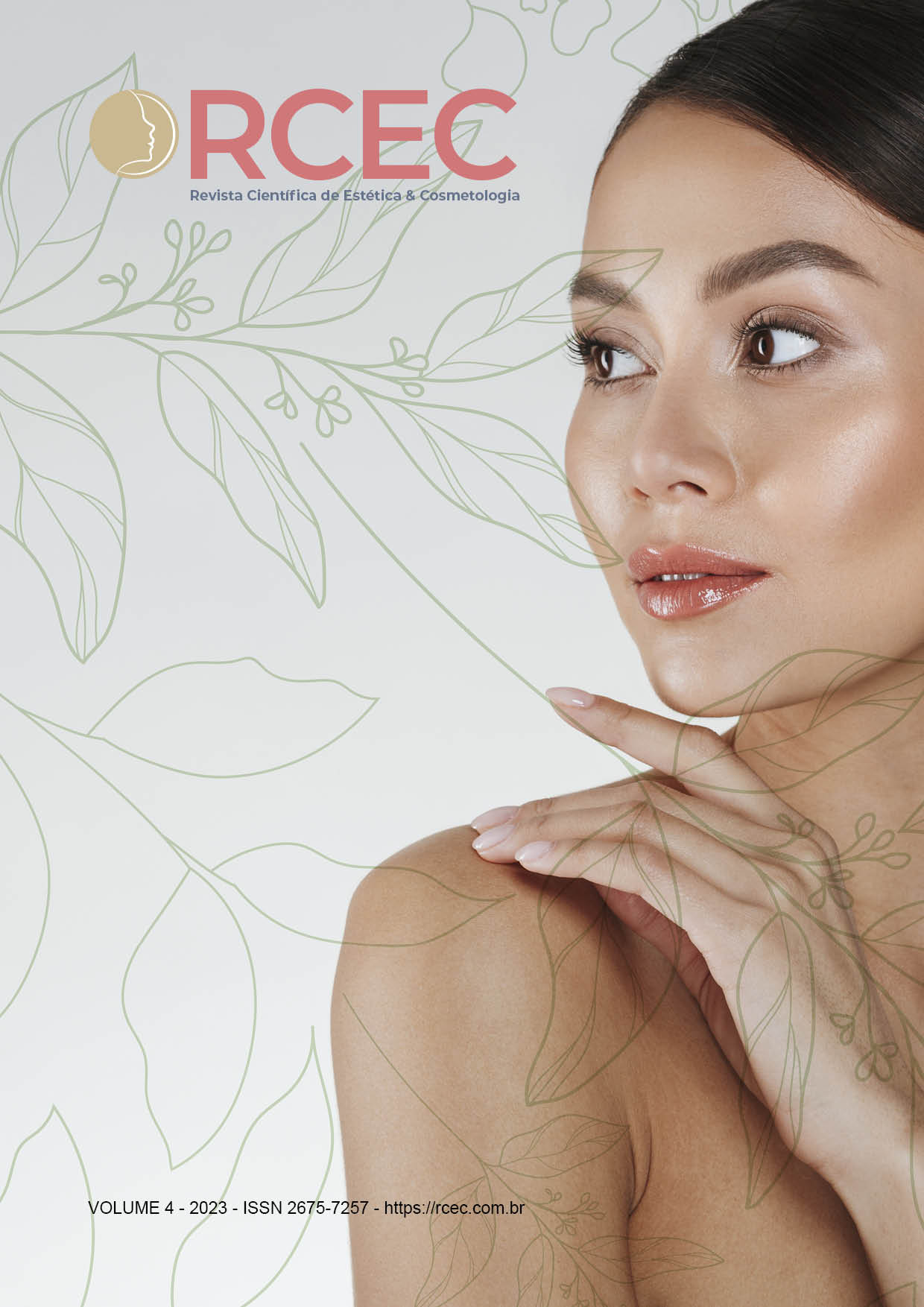Eflúvio telógeno em pacientes pós COVID-19
Main Article Content
Abstract
The present work aims to present a study on the correlation of telogen effluvium in patients post-infected by COVID-19, since after the spread of the coronavirus, a major complaint of hair loss was identified by professionals, usually after 50-60 days after the recovery from the coronavirus disease and through this research it will be possible to disseminate more knowledge on the subject, which will enable greater training of professionals, who will act in order to promote a better quality of life for patients seeking treatments for telogen effluvium and other hair loss including alopecia as well. Not all people who have been affected by COVID-19 have access to these treatments and tests that can diagnose Telogen Effluvium after COVID-19. In the current scenario of the SARS-CoV-2 pandemic, the concern for self-medication without supervision or monitoring doctor in charge, cannot be discarded to cause telogen effluvium. In summary, the global pandemic is considered a potential source of psychosocial stress, which could result in an increase in the prevalence of telogen effluvium as a result, so the relevance of continuing with regular follow-up and psychological support in patients with effluvium must be stressed. telogen in this epidemic period.
Article Details

This work is licensed under a Creative Commons Attribution 4.0 International License.
Copyright Statement - Policy Proposal for Open Access Journals
Authors who publish in the Scientific Journal of Aesthetics & Cosmetology agree to the following terms: 1 - Authors retain the copyright and grant the journal the right to first publication, with the work simultaneously licensed under the Creative Commons Attribution License allowing the sharing of the work with acknowledgment of the authorship of the work and initial publication in this magazine. 2 - Authors are authorized to assume additional contracts separately, for non-exclusive distribution of the version of the work published in this journal (eg, publishing in institutional repository or as a book chapter), with acknowledgment of authorship and initial publication in this journal. 3 - Authors are allowed and encouraged to publish and distribute their work online (eg in institutional repositories or on their personal page) at any point before or during the editorial process, as this can generate productive changes, as well as increase the impact and citation of published work.
This is an open access article under the CC-BY license
References
ASGHAR, F. et al.Telogen effluvium: a review of the literature. v. 12, n. 5, 2020
CIOTTI, M. et al.COVID-19 Outbreak: An Overview. Chemotherapy, v.64, n.5-6, p.215-223, 2019.
DENG, et al. Telogen effluvium, Beau lines, and acral peeling associated with COVID-19 infection. Jaad case reports , [S. l.], p. 138-140, 6 jun. 2021. DOI 10.1016/j.jdcr.2021.05.026. Disponível em: PubMed.
HAWWAM SA, ISMAIL M, ELHAWARY EE. The role of autologous micrografts injection from the scalp tissue in the treatment of COVID-19 associated telogen effluvium: Clinical and trichoscopic evaluation. Dermatol Ther. 2022 Jul;35(7):e15545. doi: 10.1111/dth.15545. Epub 2022 May 6. PMID: 35486375; PMCID: PMC9111843.
IZUMI, M. O.; BRANDÃO, B. J. F. Tratamento do eflúvio telógeno pós-Covid 19. BWS Journal. v.4, p.1-8, 2021
LV, et al. A case of Acute Telogen Effluvium After SARS-CoV-2 Infection. Clinical, Cosmetic and Investigational Dermatology Dovepress , [S. l.], p. 385-387, 24 mar. 2021. DOI https://doi.org/10.2147/CCID.S307982. Disponível em: https://www.dovepress.com/getfile.php?fileID=68558.
OGBUEFI N, ERICKSON T, MHLABA JM. A case of rapid progression of central centrifugal cicatricial alopecia after COVID-19 infection. JAAD Case Rep. 2022 Nov;29:89-91. doi: 10.1016/j.jdcr.2022.08.039. Epub 2022 Sep 9. PMID: 36101703; PMCID: PMC9458759.
OLDS, H. et al. Telogen effluvium associated with COVID-19 infection. Dermatologic
therapy. v. 34, n.2, 2021
ONG SWQ, ONG KHX, LEE SJ. COVID-19-induced Scalp Alopecia Treated Effectively with Stem Cell Serum. Plast Reconstr Surg Glob Open. 2022 Jun 20;10(6):e4423. doi: 10.1097/GOX.0000000000004423. PMID: 35733924; PMCID: PMC9208741.
OTSUKA et Al. Recovery From Alopecia After COVID-19. Cureus. 2022 Jan 12;14(1):e21160. doi: 10.7759/cureus.21160. PMID: 35165610; PMCID: PMC8831424.
PHONG et Al. Not just thinning: A case of alopecia universalis after mild COVID-19. JAAD Case Rep. 2022 Jul;25:1-3. doi: 10.1016/j.jdcr.2022.04.024. Epub 2022 May 7. PMID: 35571455; PMCID: PMC9078454.
RIZZETTO, et Al. Telogen effluvium related to post severe Sars-Cov-2 infection: Clinical aspects and our management experience. Dermatol Ther. 2021 Jan;34(1):e14547. doi: 10.1111/dth.14547. Epub 2020 Nov 23. PMID: 33190397; PMCID: PMC7744849.
ROSSI, et Al. Telogen Effluvium after SARS-CoV-2 Infection: A Series of Cases and Possible Pathogenetic Mechanisms. Skin Appendage Disord. 2021 Jul 8;21(5):1-5. doi: 10.1159/000517223. PMID: 34373830; PMCID: PMC8339054.
SAKI et al. Intermittent chronic telogen effluvium with an unusual dermoscopic finding following COVID-19. Clinical Case Reports , [S. l.], p. 6228, 9 ago. 2022. DOI 10.1002/ccr3.6228. Disponível em: https://www.ncbi.nlm.nih.gov/pmc/articles/PMC9361802/.
SEYFI et Al. Prevalence of telogen effluvium hair loss in COVID-19 patients and its relationship with disease severity. J Med Life. 2022 May;15(5):631-634. doi: 10.25122/jml-2021-0380. PMID: 35815081; PMCID: PMC9262270.
SHARQUIE KE, JABBAR RI. COVID-19 infection is a major cause of acute telogen effluvium. Ir J Med Sci. 2022 Aug;191(4):1677-1681. doi: 10.1007/s11845-021-02754-5. Epub 2021 Aug 31. PMID: 34467470; PMCID: PMC8407603.
TURKMEN D, et al. Evaluation of the effects of COVID-19 pandemic on hair diseases through a web-based questionnaire. Dermatol Ther. 2020 Nov;33(6):e13923. doi: 10.1111/dth.13923. Epub 2020 Jul 16. PMID: 32594627; PMCID: PMC7361059.
YILDIRIM et Al. Evaluation of patients with telogen effluvium during the pandemic: May the monocytes be responsible for post COVID-19 telogen effluvium? J Cosmet dermatol. 2022 May;21(5):1809-1815. doi: 10.1111/jocd.14883. Epub 2022 Feb 28. PMID: 35201647; PMCID: PMC9115203.


